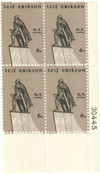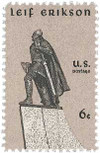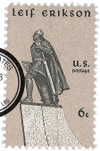
# 1359 - 1968 6c Leif Erikson
Issue Date: October 9, 1968
City: Seattle, WA
Quantity: 128,710,000
Printed By: Bureau of Engraving and Printing
Printing Method: Lithographed, engraved
Perforations: 11
Color: Light gray, brown and black brown
This stamp honors Leif Erikson, a Norse explorer who led the first known European expedition to the mainland of North America.
Erikson was born in Iceland around 980 A.D. About 985 A.D., his father, Erik the Red, founded a settlement in Greenland. About 1002 A.D., Erikson and a crew of 35 men sailed west from Greenland in search of land sighted by another sea captain. They landed in what they called Helluland – flat rock land. They traveled further south and reached Markland – forest land. Traveling farther south, they reach Vinland – or wineland. Their crew members likely made wine from cranberries or gooseberries.
Norsemen continued to travel from Greenland to Vinland for a period of about 15 years after Erikson’s discovery. Historians believe these voyages ceased due to violent confrontations with American Indians. October 9th is observed as Leif Erikson day in the United States.
Arrival Of The Restauration
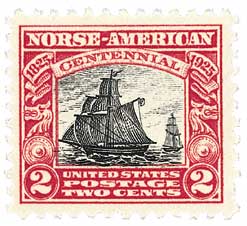
On October 9, 1825, the sloop Restauration arrived in the United States, marking what is often considered the first organized emigration from Norway to the U.S.
Norsemen from Greenland and Iceland were the first Europeans to reach America, led by Leif Erikson around the year 1000. They founded a settlement in present-day Newfoundland, Canada, but didn’t remain due to conflicts with the indigenous people.
| Remember – you can click on any of these images to find more conditions and covers to add to your collection. |
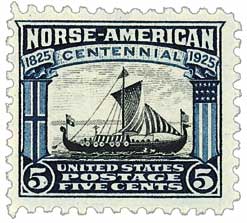
Later, in the 1600s, small groups of Norwegians settled in America, particularly New York and Pennsylvania. But the first large migration wouldn’t occur until 1825. At that time, a group of Norwegians joined together to travel to America for religious reasons. They were members of the Religious Society of Friends (Quakers) and the Haugeans.
On July 4, 1825, a group of 52 Norwegian immigrants boarded the single-masted sloop Restauration (also known as Restauration, Restoration, Restaurasjonen, and Restorasjon) in Stavanger harbor. Often called the Norwegian Mayflower, it was only about half the size of that famous ship. During the three-month journey, the ship’s occupancy increased by one, with the birth of Margaret Allen Larsen.
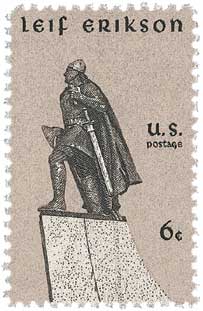
The Restauration finally arrived in New York on October 9, 1825. Upon arrival in America, the captain was arrested for carrying 52 passengers, far too many for such a small ship. President John Quincy Adams pardoned him a month later. The passengers from the ship established their first settlement at Kendall, New York.
Over the next century, some 800,000 Norwegian settlers would follow them to North America, with the majority of them settling in the U.S.
The Norse-American Stamps
U.S. #620 and its companion, #621, are known as the Norse-American stamps, honoring the arrival of Leif Erikson and the Restauration. These were among the handful of stamps produced since the 1901 Pan-Americans to feature bi-color printing, a costly and time-consuming process.
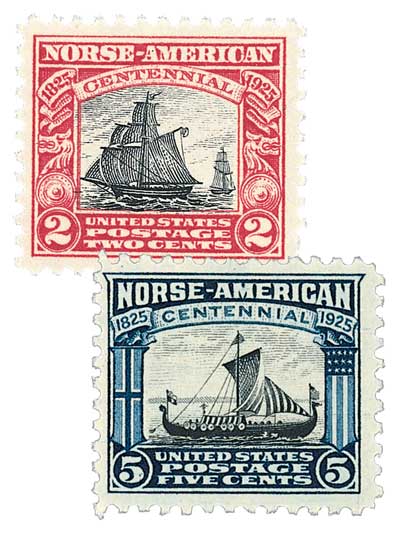
Because the stamps took so long to print, they were produced in much smaller quantities than other stamps of the day. Producing large quantities of the stamps was difficult too, because they were printed in sheets of 100, rather than 400, like most stamps at that time.
When the stamps were released, they were in great demand, with post offices around the country receiving several calls for them daily. A second printing was suggested, but was far too costly to follow through with. It has been estimated that less than 300 post offices received the stamps, with some only getting one or two sheets each, making them even more difficult to find today.
Issue Date: October 9, 1968
City: Seattle, WA
Quantity: 128,710,000
Printed By: Bureau of Engraving and Printing
Printing Method: Lithographed, engraved
Perforations: 11
Color: Light gray, brown and black brown
This stamp honors Leif Erikson, a Norse explorer who led the first known European expedition to the mainland of North America.
Erikson was born in Iceland around 980 A.D. About 985 A.D., his father, Erik the Red, founded a settlement in Greenland. About 1002 A.D., Erikson and a crew of 35 men sailed west from Greenland in search of land sighted by another sea captain. They landed in what they called Helluland – flat rock land. They traveled further south and reached Markland – forest land. Traveling farther south, they reach Vinland – or wineland. Their crew members likely made wine from cranberries or gooseberries.
Norsemen continued to travel from Greenland to Vinland for a period of about 15 years after Erikson’s discovery. Historians believe these voyages ceased due to violent confrontations with American Indians. October 9th is observed as Leif Erikson day in the United States.
Arrival Of The Restauration

On October 9, 1825, the sloop Restauration arrived in the United States, marking what is often considered the first organized emigration from Norway to the U.S.
Norsemen from Greenland and Iceland were the first Europeans to reach America, led by Leif Erikson around the year 1000. They founded a settlement in present-day Newfoundland, Canada, but didn’t remain due to conflicts with the indigenous people.
| Remember – you can click on any of these images to find more conditions and covers to add to your collection. |

Later, in the 1600s, small groups of Norwegians settled in America, particularly New York and Pennsylvania. But the first large migration wouldn’t occur until 1825. At that time, a group of Norwegians joined together to travel to America for religious reasons. They were members of the Religious Society of Friends (Quakers) and the Haugeans.
On July 4, 1825, a group of 52 Norwegian immigrants boarded the single-masted sloop Restauration (also known as Restauration, Restoration, Restaurasjonen, and Restorasjon) in Stavanger harbor. Often called the Norwegian Mayflower, it was only about half the size of that famous ship. During the three-month journey, the ship’s occupancy increased by one, with the birth of Margaret Allen Larsen.

The Restauration finally arrived in New York on October 9, 1825. Upon arrival in America, the captain was arrested for carrying 52 passengers, far too many for such a small ship. President John Quincy Adams pardoned him a month later. The passengers from the ship established their first settlement at Kendall, New York.
Over the next century, some 800,000 Norwegian settlers would follow them to North America, with the majority of them settling in the U.S.
The Norse-American Stamps
U.S. #620 and its companion, #621, are known as the Norse-American stamps, honoring the arrival of Leif Erikson and the Restauration. These were among the handful of stamps produced since the 1901 Pan-Americans to feature bi-color printing, a costly and time-consuming process.

Because the stamps took so long to print, they were produced in much smaller quantities than other stamps of the day. Producing large quantities of the stamps was difficult too, because they were printed in sheets of 100, rather than 400, like most stamps at that time.
When the stamps were released, they were in great demand, with post offices around the country receiving several calls for them daily. A second printing was suggested, but was far too costly to follow through with. It has been estimated that less than 300 post offices received the stamps, with some only getting one or two sheets each, making them even more difficult to find today.





